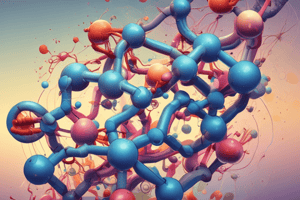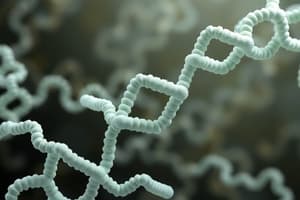Podcast
Questions and Answers
Which of the following is NOT a level of protein structure?
Which of the following is NOT a level of protein structure?
- Primary (correct)
- Quaternary
- Secondary
- Tertiary
Protein denaturation occurs when
Protein denaturation occurs when
- Protein bonds are strengthened
- Protein folding is disrupted
- Protein bonds are disrupted (correct)
- Protein bonds are formed
Which of the following can denature proteins?
Which of the following can denature proteins?
- Strong acids or bases
- Reducing agents
- Organic solvents
- All of the above (correct)
What type of interaction within a protein would be disrupted by heavy metal ions?
What type of interaction within a protein would be disrupted by heavy metal ions?
Which of the following can disrupt polar and charged interactions within proteins?
Which of the following can disrupt polar and charged interactions within proteins?
What type of amino acid side chain do heavy metals like mercury and lead bind to?
What type of amino acid side chain do heavy metals like mercury and lead bind to?
Which of the following can disrupt salt bridges within proteins?
Which of the following can disrupt salt bridges within proteins?
Which type of protein are enzymes an example of?
Which type of protein are enzymes an example of?
What is the role of enzymes in biochemical reactions?
What is the role of enzymes in biochemical reactions?
What is the function of the active site in an enzyme?
What is the function of the active site in an enzyme?
How does the induced fit model explain enzyme specificity?
How does the induced fit model explain enzyme specificity?
How can amino acids in the active site of an enzyme speed up reactions?
How can amino acids in the active site of an enzyme speed up reactions?
What are cofactors often made of?
What are cofactors often made of?
What are coenzymes typically derived from?
What are coenzymes typically derived from?
Which of the following is a coenzyme derived from vitamin B3?
Which of the following is a coenzyme derived from vitamin B3?
Which of the following is NOT a way in which cofactors and coenzymes can help enzymes speed up reactions?
Which of the following is NOT a way in which cofactors and coenzymes can help enzymes speed up reactions?
What types of bonds between the enzyme and substrate would potentially be disrupted by a change in pH?
What types of bonds between the enzyme and substrate would potentially be disrupted by a change in pH?
At what pH are lysosomal enzymes active?
At what pH are lysosomal enzymes active?
Which of the following is NOT a way in which enzyme activity can be controlled?
Which of the following is NOT a way in which enzyme activity can be controlled?
What is a common group that can be added or removed from enzymes in reversible covalent modification?
What is a common group that can be added or removed from enzymes in reversible covalent modification?
Which enzyme in glycogenesis is de-activated by phosphorylation?
Which enzyme in glycogenesis is de-activated by phosphorylation?
Which protein catalyzes phosphorylation initially?
Which protein catalyzes phosphorylation initially?
What does phosphorylation do to a protein?
What does phosphorylation do to a protein?
What prevents both pathways from running at the same time?
What prevents both pathways from running at the same time?
Which type of enzyme regulation involves covalent modification?
Which type of enzyme regulation involves covalent modification?
What is an example of covalent modification in glycogen metabolism?
What is an example of covalent modification in glycogen metabolism?
Which type of enzyme regulation involves allosteric modification?
Which type of enzyme regulation involves allosteric modification?
What can an effector molecule do to an allosteric enzyme?
What can an effector molecule do to an allosteric enzyme?
What inhibits phosphofructokinase-1 (PFK-1) allosterically?
What inhibits phosphofructokinase-1 (PFK-1) allosterically?
What is the pH range in which lysosomal enzymes function?
What is the pH range in which lysosomal enzymes function?
Flashcards are hidden until you start studying




